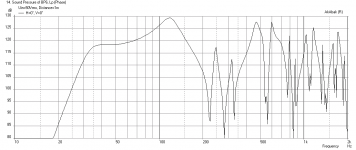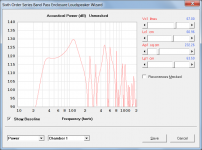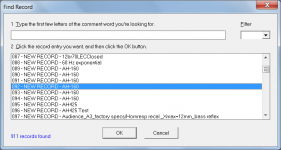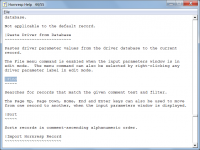WHEN DO YOU SLEEP?
I'm starting to think that David is actually a collection of different people...otherwise how on earth can he possibly be that productive?
Did you make an experimental box to verify the simulations?
LOL - that's OUR job...
I might do a series-tuned one for my next build. Not sure yet.
Hi Everyone,
CHANGE
The real-time Loudspeaker Wizard can now simulate:
1. Sixth order series band pass enclosures
2. Eighth order triple reflex band pass enclosures
3. Aperiodic bi-chamber enclosures
See the 'Sixth or Eighth Order Band Pass Enclosure' and 'Aperiodic Bi-Chamber Enclosure' entries in the 'Loudspeaker Models' section of the Hornresp Help file for further details.
The eighth order band pass enclosure model was requested by Josh in Post #5342
http://www.diyaudio.com/forums/subwoofers/119854-hornresp-535.html#post4273370
The aperiodic bi-chamber enclosure model was requested by 'Do It Yourself' in Post #5234
http://www.diyaudio.com/forums/subwoofers/119854-hornresp-524.html#post4222633
Kind regards,
David
Nice!

Thanks so much for this!
Now I see why you were asking me about the topologies of the 6th order series bandpass that I modeled in Akabak with 9 lines of script.
Last edited:
Now I see why you were asking me about the topologies of the 6th order series bandpass that I modeled in Akabak with 9 lines of script.
Hi xrk971,
There is method in my madness - I always have reasons for my questions
In the attached comparison, the subtle differences at higher frequencies are due to your AkAbak simulation showing the pressure response, whereas in Hornresp the power response is calculated (because the directivity characteristics of the system are not accurately known).
Other slight differences in peak amplitudes are due to differences in the number of plotted frequency points.
Kind regards,
David
Attachments
Did you make an experimental box to verify the simulations?
Hi Mark,
No - unfortunately I will have to leave that to others. I have to sleep sometime...
I did however check that the acoustical power response, electrical impedance, diaphragm displacement and port peak particle velocity results are the same as those calculated by AkAbak (for equivalent systems).
Note that at higher frequencies the predictions are likely to become somewhat problematic, as they will be directly influenced by the actual physical layout and the precise positioning of the chambers / ports in the constructed system. Hopefully the results will be fine at bass frequencies though
Kind regards,
David
I'm starting to think that David is actually a collection of different people...
Multiple me's - now that's a horrible thought!
Just one of me can do more than enough damage, on my own
Multiple me's - now that's a horrible thought!
Just one of me can do more than enough damage, on my own.
this reads like an incredible hulk quote.
Hi Mark,
No - unfortunately I will have to leave that to others. I have to sleep sometime....
I did however check that the acoustical power response, electrical impedance, diaphragm displacement and port peak particle velocity results are the same as those calculated by AkAbak (for equivalent systems).
Note that at higher frequencies the predictions are likely to become somewhat problematic, as they will be directly influenced by the actual physical layout and the precise positioning of the chambers / ports in the constructed system. Hopefully the results will be fine at bass frequencies though.
Kind regards,
David
I might be able to work out a system that could be a measured bench mark.
It would take some thinking to be able to make an enclosure that would have two different states. So there could be a spread in the simulation of the drivers response.
Time, all I need is more time!
this reads like an incredible hulk quote.
Just don't make DAVID BeANNER angry. You won't like him when he's angry!
Hi David,
I have always, well for a while, wished that I could hit control C while looking at the acoustical power response in the filter wizard and then
compare to another simulations power response in the filter wizard, like can be done with the raw graphs using the Compare Captured command.
The filtered power, in some cases, looks much more like the final results the system will have, especially with low LP filters.
Regardless, it is hard to say anything but wow every time I spend some time with Hornresp.
Also, a question, is there any way to get to record 92 without clicking on next 91 times.
I tried to search for this in this thread, and looked through the instructions quite a number of times but have not seen any mention of the issue.
Thank you so much David for all of your selfless work.
Dave
I have always, well for a while, wished that I could hit control C while looking at the acoustical power response in the filter wizard and then
compare to another simulations power response in the filter wizard, like can be done with the raw graphs using the Compare Captured command.
The filtered power, in some cases, looks much more like the final results the system will have, especially with low LP filters.
Regardless, it is hard to say anything but wow every time I spend some time with Hornresp.
Also, a question, is there any way to get to record 92 without clicking on next 91 times.
I tried to search for this in this thread, and looked through the instructions quite a number of times but have not seen any mention of the issue.
Thank you so much David for all of your selfless work.
Dave
This
This is fully fantastic!
David is just full of surprises!
David is like Santa only more random about the date in which he gives you gifts

This is fully fantastic!
David is just full of surprises!
David is like Santa only more random about the date in which he gives you gifts

Hi Everyone,
CHANGE
The real-time Loudspeaker Wizard can now simulate:
1. Sixth order series band pass enclosures
2. Eighth order triple reflex band pass enclosures
3. Aperiodic bi-chamber enclosures
Also, a question, is there any way to get to record 92 without clicking on next 91 times.
[CTRL]+F enter 92 or 092 it's also text search capable
Hi Dave,
I will add it to my list of 'things to look at' . Can't promise anything at this stage, though. To compare filter responses I normally just take a screenprint of the Filter Wizard form by pressing the Alt + Prt Scr keys, and then paste the image into an open blank Word document, where I can refer to it while doing further simulations.
. Can't promise anything at this stage, though. To compare filter responses I normally just take a screenprint of the Filter Wizard form by pressing the Alt + Prt Scr keys, and then paste the image into an open blank Word document, where I can refer to it while doing further simulations.
As Dan has pointed out, Crtl+F is the shortcut to the File > Find tool. To find record 92 specifically, I would normally just scroll down through the list to the 092 entry and then double-click on it to select that record. Note that in many cases it is not really necessary to use the Find tool, as it is possible to quickly 'home in' on a particular record using the Page Up, Page Down, Home, End and Enter navigation keys when the input parameters window is displayed.
It's all in the Help file .
.
Kind regards,
David
I have always, well for a while, wished that I could hit control C while looking at the acoustical power response in the filter wizard and then
compare to another simulations power response in the filter wizard, like can be done with the raw graphs using the Compare Captured command.
I will add it to my list of 'things to look at'
Also, a question, is there any way to get to record 92 without clicking on next 91 times.
As Dan has pointed out, Crtl+F is the shortcut to the File > Find tool. To find record 92 specifically, I would normally just scroll down through the list to the 092 entry and then double-click on it to select that record. Note that in many cases it is not really necessary to use the Find tool, as it is possible to quickly 'home in' on a particular record using the Page Up, Page Down, Home, End and Enter navigation keys when the input parameters window is displayed.
It's all in the Help file
Kind regards,
David
Attachments
Just don't make DAVID BeANNER angry. You won't like him when he's angry!
In my defence - it's not easy being green
Hi xrk971,
There is method in my madness - I always have reasons for my questions.
In the attached comparison, the subtle differences at higher frequencies are due to your AkAbak simulation showing the pressure response, whereas in Hornresp the power response is calculated (because the directivity characteristics of the system are not accurately known).
Other slight differences in peak amplitudes are due to differences in the number of plotted frequency points.
Kind regards,
David
This is really super useful stuff you just added - I think a lot of people have been wanting to simulate DCR's and 6th order series band pass but could not without help of akabak before.
One really big thing that would increase user friendliness for me (as I have over 200 drivers I have simulated in Akabak in a text database of TS parameters that reads like a manufacturer listing) would be ability to not have to use a point and click dialog to enter TS params. If you could have a txt box window where we can paste TS, and HR parses it like Akabak, it would make it very speedy to try many different drivers for any one geometry.
Thanks
X
- Home
- Loudspeakers
- Subwoofers
- Hornresp



